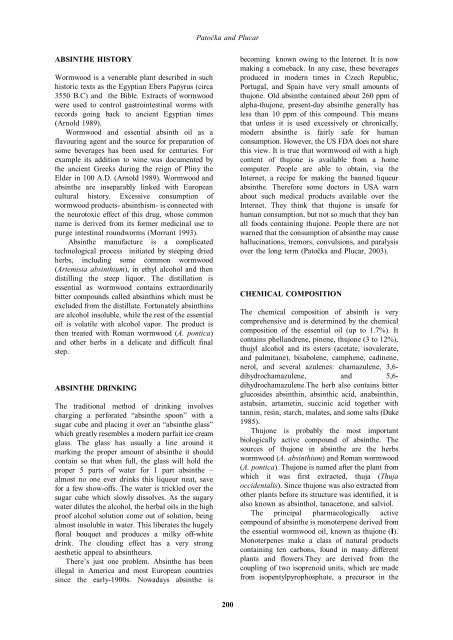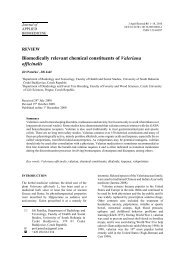Pharmacology and toxicology of absinthe
Pharmacology and toxicology of absinthe
Pharmacology and toxicology of absinthe
Create successful ePaper yourself
Turn your PDF publications into a flip-book with our unique Google optimized e-Paper software.
Patočka <strong>and</strong> Plucar<br />
ABSINTHE HISTORY<br />
Wormwood is a venerable plant described in such<br />
historic texts as the Egyptian Ebers Papyrus (circa<br />
3550 B.C) <strong>and</strong> the Bible. Extracts <strong>of</strong> wormwood<br />
were used to control gastrointestinal worms with<br />
records going back to ancient Egyptian times<br />
(Arnold 1989).<br />
Wormwood <strong>and</strong> essential absinth oil as a<br />
flavouring agent <strong>and</strong> the source for preparation <strong>of</strong><br />
some beverages has been used for centuries. For<br />
example its addition to wine was documented by<br />
the ancient Greeks during the reign <strong>of</strong> Pliny the<br />
Elder in 100 A.D. (Arnold 1989). Wormwood <strong>and</strong><br />
<strong>absinthe</strong> are inseparably linked with European<br />
cultural history. Excessive consumption <strong>of</strong><br />
wormwood products- absinthism- is connected with<br />
the neurotoxic effect <strong>of</strong> this drug, whose common<br />
name is derived from its former medicinal use to<br />
purge intestinal roundworms (Morrant 1993).<br />
Absinthe manufacture is a complicated<br />
technological process initiated by steeping dried<br />
herbs, including some common wormwood<br />
(Artemisia absinthium), in ethyl alcohol <strong>and</strong> then<br />
distilling the steep liquor. The distillation is<br />
essential as wormwood contains extraordinarily<br />
bitter compounds called absinthins which must be<br />
excluded from the distillate. Fortunately absinthins<br />
are alcohol insoluble, while the rest <strong>of</strong> the essential<br />
oil is volatile with alcohol vapor. The product is<br />
then treated with Roman wormwood (A. pontica)<br />
<strong>and</strong> other herbs in a delicate <strong>and</strong> difficult final<br />
step.<br />
ABSINTHE DRINKING<br />
The traditional method <strong>of</strong> drinking involves<br />
charging a perforated “<strong>absinthe</strong> spoon” with a<br />
sugar cube <strong>and</strong> placing it over an “<strong>absinthe</strong> glass”<br />
which greatly resembles a modern parfait ice cream<br />
glass. The glass has usually a line around it<br />
marking the proper amount <strong>of</strong> <strong>absinthe</strong> it should<br />
contain so that when full, the glass will hold the<br />
proper 5 parts <strong>of</strong> water for 1 part <strong>absinthe</strong> –<br />
almost no one ever drinks this liqueur neat, save<br />
for a few show-<strong>of</strong>fs. The water is trickled over the<br />
sugar cube which slowly dissolves. As the sugary<br />
water dilutes the alcohol, the herbal oils in the high<br />
pro<strong>of</strong> alcohol solution come out <strong>of</strong> solution, being<br />
almost insoluble in water. This liberates the hugely<br />
floral bouquet <strong>and</strong> produces a milky <strong>of</strong>f-white<br />
drink. The clouding effect has a very strong<br />
aesthetic appeal to <strong>absinthe</strong>urs.<br />
There’s just one problem. Absinthe has been<br />
illegal in America <strong>and</strong> most European countries<br />
since the early-1900s. Nowadays <strong>absinthe</strong> is<br />
becoming known owing to the Internet. It is now<br />
making a comeback. In any case, these beverages<br />
produced in modern times in Czech Republic,<br />
Portugal, <strong>and</strong> Spain have very small amounts <strong>of</strong><br />
thujone. Old <strong>absinthe</strong> contained about 260 ppm <strong>of</strong><br />
alpha-thujone, present-day <strong>absinthe</strong> generally has<br />
less than 10 ppm <strong>of</strong> this compound. This means<br />
that unless it is used excessively or chronically,<br />
modern <strong>absinthe</strong> is fairly safe for human<br />
consumption. However, the US FDA does not share<br />
this view. It is true that wormwood oil with a high<br />
content <strong>of</strong> thujone is available from a home<br />
computer. People are able to obtain, via the<br />
Internet, a recipe for making the banned liqueur<br />
<strong>absinthe</strong>. Therefore some doctors in USA warn<br />
about such medical products available over the<br />
Internet. They think that thujone is unsafe for<br />
human consumption, but not so much that they ban<br />
all foods containing thujone. People there are not<br />
warned that the consumption <strong>of</strong> <strong>absinthe</strong> may cause<br />
hallucinations, tremors, convulsions, <strong>and</strong> paralysis<br />
over the long term (Patočka <strong>and</strong> Plucar, 2003).<br />
CHEMICAL COMPOSITION<br />
The chemical composition <strong>of</strong> absinth is very<br />
comprehensive <strong>and</strong> is determined by the chemical<br />
composition <strong>of</strong> the essential oil (up to 1.7%). It<br />
contains phell<strong>and</strong>rene, pinene, thujone (3 to 12%),<br />
thujyl alcohol <strong>and</strong> its esters (acetate, isovalerate,<br />
<strong>and</strong> palmitane), bisabolene, camphene, cadinene,<br />
nerol, <strong>and</strong> several azulenes: chamazulene, 3,6-<br />
dihydrochamazulene, <strong>and</strong> 5,6-<br />
dihydrochamazulene.The herb also contains bitter<br />
glucosides absinthin, absinthic acid, anabsinthin,<br />
astabsin, artametin, succinic acid together with<br />
tannin, resin, starch, malates, <strong>and</strong> some salts (Duke<br />
1985).<br />
Thujone is probably the most important<br />
biologically active compound <strong>of</strong> <strong>absinthe</strong>. The<br />
sources <strong>of</strong> thujone in <strong>absinthe</strong> are the herbs<br />
wormwood (A. absinthium) <strong>and</strong> Roman wormwood<br />
(A. pontica). Thujone is named after the plant from<br />
which it was first extracted, thuja (Thuja<br />
occidentalis). Since thujone was also extracted from<br />
other plants before its structure was identified, it is<br />
also known as absinthol, tanacetone, <strong>and</strong> salviol.<br />
The principal pharmacologically active<br />
compound <strong>of</strong> <strong>absinthe</strong> is monoterpene derived from<br />
the essential wormwood oil, known as thujone (I).<br />
Monoterpenes make a class <strong>of</strong> natural products<br />
containing ten carbons, found in many different<br />
plants <strong>and</strong> flowers.They are derived from the<br />
coupling <strong>of</strong> two isoprenoid units, which are made<br />
from isopentylpyrophosphate, a precursor in the<br />
200





